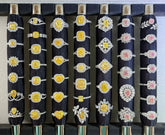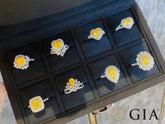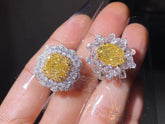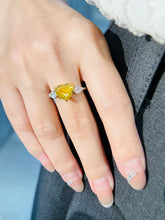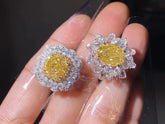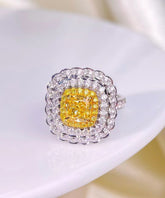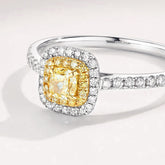How to Choose a Wedding Ring that Matches Your Engagement Ring
Choosing a wedding ring that complements your engagement ring is a crucial decision, much like finding the final piece of a puzzle. The engagement ring symbolizes your decision and commitment, while the wedding ring represents a lifelong promise.
If your engagement ring has a unique design, gemstone shape, or distinctive setting, finding a matching wedding ring can be a challenge. However, there are several methods to help you achieve this goal. First, consider selecting a wedding ring that matches the metal type of your engagement ring, which is a traditional choice. However, mixing metals such as white gold, gold, and rose gold is becoming increasingly popular to create a unique look.
Secondly, it's important to decide whether you want the wedding ring to sit flush with the engagement ring. A flush ring creates a seamless, integrated appearance, making the two rings look like a single unit. If the shape or setting of your engagement ring isn't suitable for a straight band, you can opt for a curved or contoured band to achieve this effect.
When choosing the type of ring, you have various options to reflect your personality and enhance the beauty of your engagement ring. Stackable rings are a popular choice, allowing you to mix and match different designs and textures to wear alongside your engagement ring. Alternatively, contour rings are designed to complement the curves of your engagement ring, adding modernity and uniqueness.
Whichever style you choose, ensuring your wedding ring and engagement ring create a harmonious overall appearance is key. Jewelry experts can provide customized advice to help you find the perfect match, allowing you to proudly wear this set of rings for a lifetime.
So, where do you start? Keep reading to discover our stylist's tips on how to create your dream bridal ensemble.

Choosing wedding rings that complement your engagement ring involves several steps to ensure a harmonious and stylish combination.
Step 1: Choose the Metal
Traditionally, people tend to select a wedding ring that matches the metal type of their engagement ring. However, mixed metal wedding ring sets are becoming increasingly popular. By combining metals like white gold, gold, and rose gold, you can create unique and stunning combinations. Use our Find My Match Wedding Ring tool to help find the metal combination that best suits your wedding ring set.
Step 2: Determine the Importance of Flush Fit Deciding how crucial flush fitting is to you will help determine the type of wedding ring you need.
A flush fit wedding ring seamlessly aligns with your engagement ring, creating a unified and seamless appearance. If you can't find a straight band that matches your engagement ring, consider curved or contoured bands that can neatly encircle the center gemstone or setting of your engagement ring to achieve a similar effect.
Step 3: Choose the Type of Wedding Ring Among the myriad of choices available, finding a wedding ring style that reflects your personality and enhances the beauty of your engagement ring is crucial. Here are some popular types of wedding rings:
-
Stacking Rings: Versatile and customizable, these rings allow you to mix and match different designs, gemstones, and textures, and can be worn together with your engagement ring on the same finger.
-
Contoured Rings: Uniquely designed to complement the curvature of your engagement ring, these rings add a modern and distinctive touch to your bridal set.
-
Classic Solid Metal Bands: Timeless and elegant, crafted from gold, silver, platinum, or titanium, these rings are ideal for those who appreciate simplicity and traditional styles.
-
Channel Set Bands: Featuring specially designed grooves or notches for diamonds or gemstones, these bands perfectly complement an engagement ring or other bands, offering both comfort and style.
-
Diamond Bands: Adorned with sparkling diamonds either partially or fully encircling the band, these rings add extra brilliance and charm to your ring finger.
-
Ring Wraps: Enhance the appearance of your engagement ring with bands that wrap around both sides, often adorned with additional diamonds, gemstones, or intricate designs.
-
Open Rings: Modern in style with openings or gaps on the top, these rings can be left empty or set with diamonds or gemstones, offering a fresh and unique interpretation of traditional wedding rings.
Each ring has its own unique characteristics, making the process of choosing the perfect wedding ring set both delightful and rewarding.
How to Choose Wedding Rings that Match Your Engagement Ring
When selecting a wedding ring that complements a specific type of engagement ring, considering each ring's unique shape and design is crucial. Here are recommendations for different types of engagement rings:
Emerald Cut Engagement Ring:Choosing a Matching Wedding Ring: The most suitable wedding ring may be a simple yet elegant white gold or yellow gold band to highlight the color and shape of the emerald cut. Consider selecting a contoured ring or one with small diamonds or green gemstones inset to enhance the overall appearance.
Marquise Cut Engagement Ring:Choosing a Matching Wedding Ring: The distinctive shape of a marquise cut requires a specially designed wedding ring to ensure a perfect fit. Consider a slightly curved ring or one with small gemstones or diamonds that match the main stone to enhance its visual appeal.
Oval Cut Engagement Ring:Choosing a Matching Wedding Ring: Oval cut rings are typically sleek and clean, making them suitable for simple yet refined wedding rings. Consider a classic metal band or a delicate chain design that wraps around the finger to emphasize the elegant contour of the oval ring.
Pear shaped Engagement Ring:Choosing a Matching Wedding Ring: The unique shape of a pear cut ring requires a wedding ring that fits snugly and enhances its appearance. Consider a contoured ring with small diamonds or gemstones, or a wrap-around design extending along the finger to highlight the pear shape's unique charm.
Three Stone Engagement Ring:Choosing a Matching Wedding Ring: Three stone rings often feature a prominent center stone and two side stones. A wedding ring can opt for a simple yet elegant metal band or one with additional small diamonds or gemstones to maintain overall balance and harmony.
Solitaire Engagement Ring:Choosing a Matching Wedding Ring: The focus of a solitaire ring is the single central gemstone. A wedding ring can opt for a simple metal band or one that extends along the finger with small gemstones to enhance the visual appeal and uniqueness of the solitaire gemstone.
Hidden Halo Engagement Ring:Choosing a Matching Wedding Ring: The design of a hidden halo ring requires a wedding ring that harmonizes with its halo style. Consider a wrap-around ring or one with additional small diamonds or gemstones to enhance the overall halo effect and brightness of the ring.
Halo Engagement Ring:Choosing a Matching Wedding Ring: Halo rings feature a circular design surrounding the main stone or ring. A wedding ring can opt for a simple yet elegant metal band or one with additional small diamonds or gemstones of a similar shape to enhance the overall halo effect and visual appeal.
Pavé Engagement Ring:Choosing a Matching Wedding Ring: Pave rings typically have decorative edge designs. A wedding ring can opt for a ring that coordinates with the edge design or one with additional small diamonds or gemstones of a similar style to enhance the overall decorative effect and delicacy of the ring.
When choosing a wedding ring that complements your type of engagement ring, the key is to maintain overall coordination and balance to highlight each ring's unique charm and design features.
Here is the translation of the common questions about wedding ring pairing:
-
Which wedding ring matches my engagement ring?Choosing a wedding ring that matches your engagement ring typically involves considerations of metal type and design style. Traditionally, wedding rings are selected in the same metal type as the engagement ring, such as white gold, yellow gold, or rose gold. In terms of design, you can opt for a ring that complements the shape and style of your engagement ring, such as a flush fit band or a contoured ring, to create a unified and elegant look.
-
Should the engagement ring match the wedding ring?Yes, engagement rings and wedding rings are typically designed to complement each other as a set. Together, they form your bridal set, showcasing your commitment and personal style. Choosing matching rings enhances the overall aesthetic and coherence.
-
How do I combine the wedding ring and engagement ring together?Combining the wedding ring and engagement ring involves ensuring they fit together both aesthetically and comfortably. Common methods include choosing a flush fit ring or using a ring wrap, which is a decorative band that wraps around and secures both rings to appear as one. Alternatively, selecting a design that allows the engagement ring's gemstone or setting to elegantly nest within the wedding ring's design can achieve a seamless look.
-
How can I secure the wedding ring and engagement ring together without soldering?If you prefer not to solder the rings together permanently, you can consider using a ring wrap or selecting a design that naturally integrates them. A ring wrap is a popular choice as it encircles and secures both rings without requiring permanent bonding. Additionally, some designs feature grooves or notches that allow the rings to interlock securely without soldering.

By employing these methods, you can ensure that your engagement ring and wedding ring are seamlessly integrated in both appearance and function, reflecting your personality and enduring commitment.
